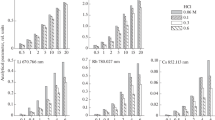Abstract
Standard reference materials of limestone, granite and argillite were analyzed by X-ray fluorescence spectrometry (XFS), flame and graphite furnace atomic absorption spectrometry (F-AAS and G-AAS), and inductively coupled plasma atomic emission spectrometry (ICP-AES). The major elements Al, Ca, Fe, Si and Ti were determined by XFS and ICP-AES. The relative standard deviations (RSD) of the concentrations of the corresponding oxides obtained by XFS and ICP-AES were (1.36±0.51)% (n=18) and (1.30±0.70)% (n=17), respectively, on the average. The relative deviations (RD) from the certified values were (1.29±3.01)% (n=18) and (−0.69±5.48)% (n=14), respectively, on the average. The numbers in parentheses are the numbers of the single RSD- and RD-values used for the calculation of the averages and the relative standard deviations. Some minor and trace elements of the standard reference materials were determined by G-AAS and ICP-AES. The precision (RSD) was markedly better in the case of ICP-AES. On the other hand, the accuracy (RD) of both methods was about the same (7%). Apparently, the precision and the accuracy are primarily determined by the measuring technique and the sample pretreatment procedure, respectively. The analytical power of the combined use of atomic spectrometric methods is also discussed.
Similar content being viewed by others
References
B. P. Fabbi, Geology, in:X-Ray Spectrometry, 1st Ed. (H. K. Herglotz, L. S. Birks, eds.), Dekker, New York, 1978, p. 297.
B. Magyar,Guide-Lines to Planning Atomic Spectrometric Analysis, Akadémia Kiadò, Budapest, and Elsevier, Amsterdam, 1982, p. 130.
B. Magyar,CRC Crit. Rev. Anal. Chem. 1987,17, 145.
M. Thompson, S. J. Wood, Atomic Absorption Methods in Applied Geochemistry, in:Atomic Absorption Spectrometry (J. E. Cantle, ed.), Elsevier, Amsterdam, 1982, p. 261.
P. W. J. M. Boumans, Line Selection and Spectral Interferences, in:Inductively Coupled Plasma Emission Spectroscopy, Part I: Methodology, Instrumentation and Performance, Wiley, New York, 1987, p. 392.
Atomic Absorption Methods Manual, Vol. 1 (1978) andVol. 2 (1976) (R. F. Laza, ed.), Instrumentation Laboratory, Wilmington, USA.
D. Nygaard,Methods Manual, Inductively Coupled Plasma, Allied Analytical Systems, Andover, USA, 1983.
B. Magyar, P. Lienemann, H. Vonmont,Spectrochim. Acta 1986,41B, 27.
B. Magyar, B. Wampfler, J. Zihlmann,GIT Fachz. Lab. 1984,28, 301.
K. A. Brownlee,Statistical Theory and Methodology in Science and Engineering, Wiley, New York, Chapt. 11.
J. C. Miller, J. N. Miller,Statistics for Analytical Chemistry, Ellis Horwood, Chichester, 1984, Chapt. 4.
Nomenclature, Symbols, and Units and Their Usage in Spectrochemical Analysis-II: Data Interpretation,Pure Appl. Chem. 1976,45, 99;Spectrochim. Acta 1978,33B, 241.
B. Magyar, F. Aeschbach, H. Vonmont,Fresenius' Z. Anal. Chem. 1978,291, 193.
Author information
Authors and Affiliations
Rights and permissions
About this article
Cite this article
Magyar, B., Takacs, K. Combined use of atomic spectrometric methods in the analysis of rocks. Mikrochim Acta 96, 183–195 (1988). https://doi.org/10.1007/BF01236103
Received:
Revised:
Issue Date:
DOI: https://doi.org/10.1007/BF01236103




